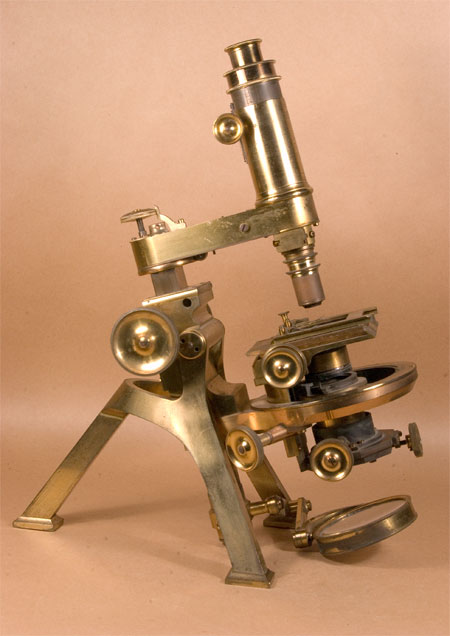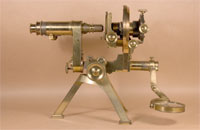 |
|||||
 |
 |
||||
 |
|||||
 |
 |
||||
Powell & Lealand Model No. 1 Compound Microscope (No. 149 ) |
|||||||||||
 |
|||||||||||
| Age: c1870 Made by: Powell & Lealand Made in: England |
|||||||||||
 |
|||||||||||
 |
|||||||||||
 |
|||||||||||
|
Imaging
|
|||||||||||
|
This instrument was manufactured by Powell & Lealand, one of the most celebrated optical companies of the 19th Century. The design, "Model No. 1", is perfect in nearly every regard. It is beautifully manufactured and assembled, with components that are precision machined and still in good working order. Hogg (1898) stated that "...it represents the results of sixty years' steady devotion to secure perfection..." Turner (1989) describes this model as being "the most famous of all microscopes, the aristocrat of the Victorian period." Hugh Powell (1799–1883) was an instrument maker residing at 24 Clarendon St., Somers Town, London. His first recorded contribution to microscopy was a precision microscope stage introduced in 1832. The following year he added fine adjustment to the stage movement*. Hugh Powell continued to make microscope components under his own name until 1841 when the RMS ordered three microscopes; one each from Powell, Andrew Ross, and James Smith. The Council of the Society intended for these makers to create instruments that represented the best design principles of the day. This event catalyzed the partnership of Powell and his brother-in-law P.H. Lealand, and on Dec. 22, 1841 Powell & Lealand delivered their first microscope to the RMS. Their new instrument predicted the design that appeared a few years later. The London Physiological Journal, Nov. 1843, described it as being "...the first instance of a Microscope hanging in a tripod in the same way that a kettle hangs from a tripod of sticks in a gipsy's (sic) encampment... This is also the first Microscope where the fine adjustment moves the nosepiece by means of a lever inside a bar movement..." They created a large brass instrument incorporating a tripod base, trunnion-supported main tube, rack coarse focus, "long-lever" fine focusing, and compound substage—a design that remained their basic instrument model for over 60 years. After the death of Hugh Powell, his son Thomas Powell continued the firm creating microscopes, and especially high-quality objectives. "Many Fellows of the Society will recollect the 1/40th objective which he was accustomed to exhibit on Pond Life nights, and which he made when over 70 years of age."** The firm of Powell & Lealand ended with the death of Thomas Powell in 1924. The Golub Collection is fortunate to have several Powell & Lealand models: Model No. 1 (this instrument), Model No. 2, an early braced Model No. 2, and a Student model. Models No. 1 and 2 are compared here. The microscope shown on this page is a large, brass monocular compound microscope, on a massive tripod base. The base supports trunnions attached to the main support tube and coarse focusing mechanism. This allows the instrument to be tilted from vertical to fully horizontal. Coarse focus is by rack and pinion. Fine focus is via the "long lever" mechanism. The body tube support arm has a cutout for insertion of a prism (Wenham or P&L) for binocular vision. Both the prism and binocular tubes are missing. The mirror is double-sided and is supported on an articulating arm and half-gimbal. The achromatic condenser has two optics, an iris, and two filter holders. It can be centered via X and Y controls as well as rotated. It has coarse focus only. The large X, Y mechanical stage can also be rotated. Optics of this microscope consist of a single eyepiece and field lenses. The only objective with this instrument has two lenses within an unmarked tube. The body tube can be elongated via rack and pinion to accommodate different mechanical tube length objectives. There are two accessories with this instrument: a silver side-reflector for epi-illumination and a camera lucida eyepiece. A mahogany case is included with this instrument. It is signed on the body tube support arm Powell & Lealand, 170 Euston Road, London. When it was new, the complete Model No. 1 microscope kit, including three body tubes and objectives, sold for approximately £200. This instrument was most likely manufactured sometime around 1870. Clues to its early manufacture are the lack of condenser fine focus, fully rotating stage, and short English draw tube (calibrated 0–1.5). A Powell & Lealand instrument similar to this one was described in the 1867 edition of The Microscope by Hogg. Featured 01/08; 01/20 *RMS Transactions, 1832, 1833 See Bibliography for more references. |
|||||||||||